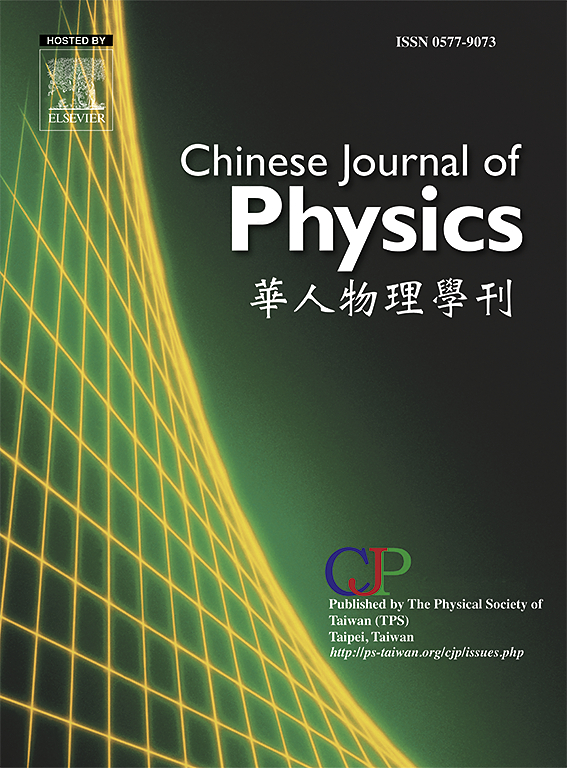Deformed boson statistics and primordial black hole production under slow expansion conditions
IF 4.6
2区 物理与天体物理
Q1 PHYSICS, MULTIDISCIPLINARY
引用次数: 0
Abstract
The Planck scale physics remains largely unexplored, and understanding the complete quantum theory of gravity may unveil the Universe mysteries that lie beyond this scale. This paper investigates the production of primordial black holes within a thermodynamic framework in an expanding Friedmann–Robertson–Walker (FRW) universe. We leverage the established principle that particle collisions can result in black hole formation when particles are confined within the Schwarzschild radius corresponding to their center of mass energy, a concept known as a variant of the hoop conjecture. Initially, we extend the hoop conjecture to apply to an expanding FRW universe. Our findings reveal that the critical formula derived is significantly influenced by the Hubble parameter, which describes the rate of cosmic expansion, and it effectively aligns with established spacetime limits. Subsequently, we utilize our generalized formula to compute the number density of black holes generated from particle collisions in the hot system of an early expanding FRW universe as a function of temperature and deformation parameter . We propose that at certain temperatures, the density of black holes may dominate. Our analysis indicates that conditions beyond the Planck temperature are plausible under deformed bosonic statistics. Furthermore, we examine scenarios in the early universe when temperatures surpassed the Planck temperature, concluding that deformed statistics are consistent with the extremely high temperatures characteristic of that epoch. Although black holes may proliferate under these elevated thermal conditions, they are predicted to overshadow background radiation when temperatures beyond those typical at the Planck scale. This study contributes to our understanding of primordial black holes and their formation mechanisms in the context of an expanding universe, providing insights into conditions that may have existed shortly after the Big Bang. In fact, we examine the beyond Planck temperature in the early universe and deduce that deformed statistics are consistent with the extremely high temperatures present in the early universe.

慢膨胀条件下变形玻色子统计和原始黑洞的产生
普朗克尺度的物理学在很大程度上仍未被探索,而理解完整的引力量子理论可能会揭开普朗克尺度之外的宇宙奥秘。本文研究了在膨胀的弗里德曼-罗伯逊-沃克(FRW)宇宙的热力学框架内的原始黑洞的产生。我们利用了既定的原理,即当粒子被限制在与其质能中心对应的史瓦西半径内时,粒子碰撞可以导致黑洞形成,这一概念被称为环猜想的变体。首先,我们将环猜想推广到一个膨胀的FRW宇宙。我们的研究结果表明,推导出的关键公式受到哈勃参数的显著影响,该参数描述了宇宙膨胀的速度,它有效地与既定的时空限制保持一致。随后,我们利用我们的广义公式计算了FRW宇宙早期膨胀热系统中粒子碰撞产生的黑洞数密度(nbh)作为温度和变形参数q的函数。我们提出在一定温度下,黑洞密度可能占主导地位。我们的分析表明,在形变玻色子统计下,超过普朗克温度的条件是合理的。此外,我们研究了早期宇宙中温度超过普朗克温度的情景,得出的结论是,变形统计与那个时代的极高温度特征是一致的。虽然黑洞可能会在这种高温条件下增殖,但据预测,当温度超过普朗克尺度的典型温度时,它们会掩盖背景辐射。这项研究有助于我们了解宇宙膨胀背景下的原始黑洞及其形成机制,为大爆炸后不久可能存在的条件提供见解。事实上,我们研究了早期宇宙中的超普朗克温度,并推断出变形统计与早期宇宙中存在的极高温度是一致的。
本文章由计算机程序翻译,如有差异,请以英文原文为准。
求助全文
约1分钟内获得全文
求助全文
来源期刊

Chinese Journal of Physics
物理-物理:综合
CiteScore
8.50
自引率
10.00%
发文量
361
审稿时长
44 days
期刊介绍:
The Chinese Journal of Physics publishes important advances in various branches in physics, including statistical and biophysical physics, condensed matter physics, atomic/molecular physics, optics, particle physics and nuclear physics.
The editors welcome manuscripts on:
-General Physics: Statistical and Quantum Mechanics, etc.-
Gravitation and Astrophysics-
Elementary Particles and Fields-
Nuclear Physics-
Atomic, Molecular, and Optical Physics-
Quantum Information and Quantum Computation-
Fluid Dynamics, Nonlinear Dynamics, Chaos, and Complex Networks-
Plasma and Beam Physics-
Condensed Matter: Structure, etc.-
Condensed Matter: Electronic Properties, etc.-
Polymer, Soft Matter, Biological, and Interdisciplinary Physics.
CJP publishes regular research papers, feature articles and review papers.
 求助内容:
求助内容: 应助结果提醒方式:
应助结果提醒方式:


